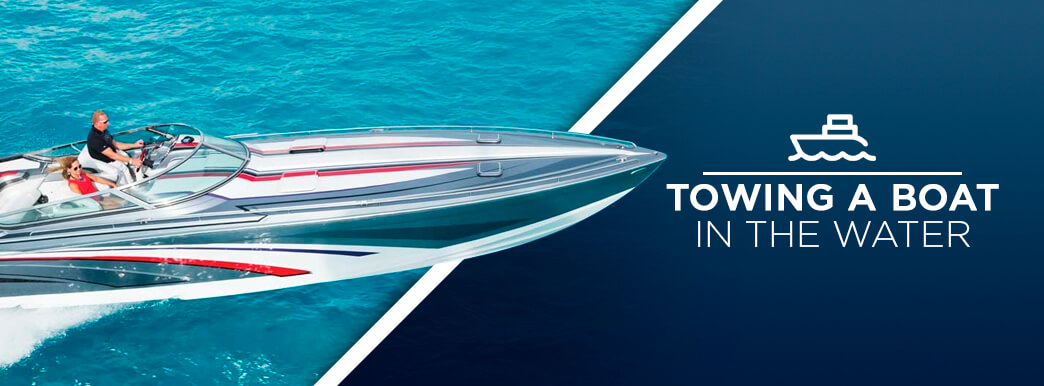
Avid boaters have a high chance of experiencing a breakdown or coming across a disabled boat. It’s not the most common issue, but the more you’re on the water, the more likely you are to see a stranded craft. If you do, you should help the boater in need, as you could find yourself in the same position eventually. If it’s an emergency, the best course of action is contacting a professional boat towing service or the U.S. Coast Guard.
To effectively and efficiently pull a boat, you’ll need to know the right steps for success. There are several factors to consider, including the size and shape of both boats, the towing vessel’s horsepower, weather conditions, water depth and more. This guide will provide you with some of the best tips for towing a disabled boat and utilizing tow services, should you need them.
10 Tips for Towing a Boat
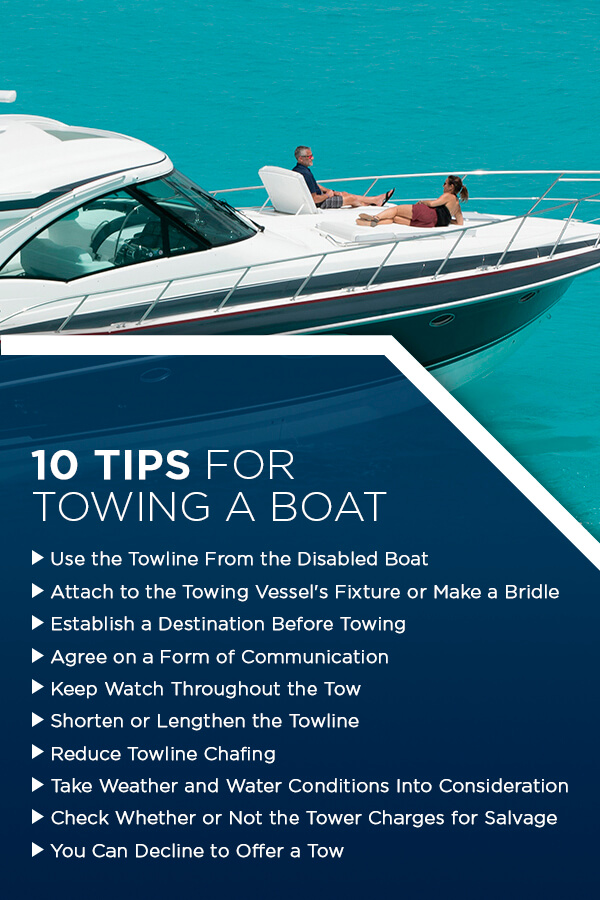
When a boat becomes disabled, it can no longer propel itself to land. It needs another boat to tow it back to safety. Whether you’re manning the disabled craft or you stumble upon one on while boating, knowing how to tow a boat could save you or the other boater from being stranded.
Here are 10 tips for the best procedures when towing a boat:
1. USE THE TOWLINE FROM THE DISABLED BOAT
When deciding how to tow, it’s best to tow astern by using the line from the disabled boat. If it’s available, a nylon anchor rope makes for the best possible tow, as the line is typically available, long in length and has the flexibility to allow for adjustments and shock absorbency. Once you’ve finished towing, you can easily cast off the rope from the vessel and continue on your way.
2. ATTACH TO THE TOWING VESSEL’S FIXTURE OR MAKE A BRIDLE
You need to ensure the connection between the towing and disabled vessel is secure and strong. Boats that have a towing fixture or pylon near their centerline are ideal for pulling smaller crafts, especially if the attachment is meant for wake-boarding or skiing. These fixtures are typically close to the natural pivot point of the vessel, making it a great choice for attaching a towline.
If towing from a fixture isn’t an option on your vessel, you’ll have to get a little more creative. The next best method is to make a bridle out of a strong line. You should be able to attach it between the two stern cleats. Once your bridle is in place, you can attach a bowline to tow, which will allow it to glide back and forth on the bridle without resistance. The bridle should be loose enough to allow for movement, but tight enough to keep it away from your propeller. Once you’re finished, you can dismantle it by uncleating one side of the bridle and slipping the towline off.
3. ESTABLISH A DESTINATION BEFORE TOWING
Before you begin towing, you need to talk with the owner of the boat and decide where you’re taking the vessel. Rather than assume, it’s best to have a conversation about it beforehand. If you have a plan in place, it’s easier to communicate clearly while towing a boat on the water.
Beyond the towing destination, it’s also essential to discuss contingency plans. There are several obstacles that could arise throughout the tow, such as low fuel, incoming weather, tide shifts, issues with the line and any other number of situations. Discuss these possibilities beforehand and come up with a few emergency plans, so that you aren’t left scrambling if any problems arise.
4. AGREE ON A FORM OF COMMUNICATION
Along with having a plan in place, it’s also essential to establish a line of communication between the two boats. Keeping in touch throughout the tow is essential to success, as you’ll be able to contact one another if something goes wrong or if you need to make a change to the plans. So, you need to ensure you have a common form of communication. One of the best options is a corresponding very high-frequency (VHF) radio channel that isn’t reserved for emergencies and cell phones. You can also resort to hand signals, if necessary.
5. KEEP WATCH THROUGHOUT THE TOW
When all the plans are discussed, and your towline is successfully attached, you can begin your towing journey. Advance slowly to remove the slack from the line — then, as you’re pulling the full weight, you can begin to throttle up and reach your desired speed. But that’s not where your attention should end. You need to keep a tow watch throughout the entire process. If there are any issues, you’ll catch them before they pose larger problems or compromise your ability to tow.
6. SHORTEN OR LENGTHEN THE TOWLINE
Depending on the circumstances, you may need to adjust the length of your towline. One of the biggest determining factors is where you’re towing. In open water, it’s best to have a long tow-line, as it provides distance between your vessel and the disabled boat and works as a shock absorber.
When you’re towing another vessel through large waves, you should choose the line length that will keep the boats in sync. The boats need to hit wave troughs and crests in time with one another. If they don’t, it could cause damages that prevent you from towing further or potentially injure passengers.
If the waters are calm or you need to maneuver with more accuracy, shortening the towline will help. It makes it easier to pull into docks or ramps without damaging the structures or the disabled boat. A short towline can be a huge help, but keep in mind that even when you stop or slow your vessel, it doesn’t always mean the towed boat will move at the same pace. With a short line, you have a higher chance of a collision.
7. REDUCE TOWLINE CHAFING
One of the main concerns with towlines is chafing. Chafing can occur wherever the line touches either of the boats, and the friction and pressure create heat. Nylon is susceptible to breaking down under strain and heat, so chafing can be detrimental to your towing attachment. To protect your nylon line, you need to create guards to keep the rope from rubbing against the boat. While anti-chafing gear is the best option, you can also use a fire hose, pieces of canvas or even old t-shirts — any kind of cloth to prevent friction on the boat tow rope.
8. TAKE WEATHER AND WATER CONDITIONS INTO CONSIDERATION
If you come across a stranded boat, your first instinct will likely be to try and help. However, in some cases, it’s best to leave it to the professionals. If the weather conditions are bad or the water is too choppy, attempting to safely tow a boat can be dangerous for both parties. Your best bet is to call in the U.S. Coast Guard for assistance, as they are trained to handle rough conditions and towing boats at sea. You can call them on a VHF radio, on channel 16.
Once you alert the coast guard, keep them informed of your location and what you’re doing to help, if you can do anything. If the weather is too bad, the most you may be able to do is stand by until help can arrive. If it’s safe enough, you can also take the passengers of the disabled boat aboard to keep them out of danger.
9. CHECK WHETHER OR NOT THE TOWER CHARGES FOR SALVAGE
If you’re in a situation where you need towing and a vessel approaches with an offer, check to see whether or not they want money in return. They may try to claim salvage rights, meaning the person who rescues a boat and pulls it back to shore is entitled to a reward. While it’s unusual that someone would claim salvage, it all depends on the individual offering the tow. It’s best to ask whether or not they require payment before attaching any towlines.
While it’s almost immoral to try to claim salvage on a small boat, it’s reasonable for the owner of the towing vessel to ask for reimbursement, should their boat take on any damages. Any monetary compensation and charges should be settled before you start towing, so there aren’t any surprises when you reach shore. If there are any disagreements, you can easily settle them by citing the U.S. Coast Guard’s Good Samaritan laws.
10. YOU CAN DECLINE TO OFFER A TOW
While it is customary to offer help if you can, you aren’t required to tow a disabled boat if you run into one. There are many circumstances under which towing could put you, your passengers and those on the disabled vessel at risk. High waves, strong currents and inclement weather can all make towing dangerous, and if your boat is too small to pull the extra weight, you could end up stranded. There are plenty of other ways to help — even just standing by while they attempt to fix the situation can help.
Towing Services and Assistance If You Need Towing
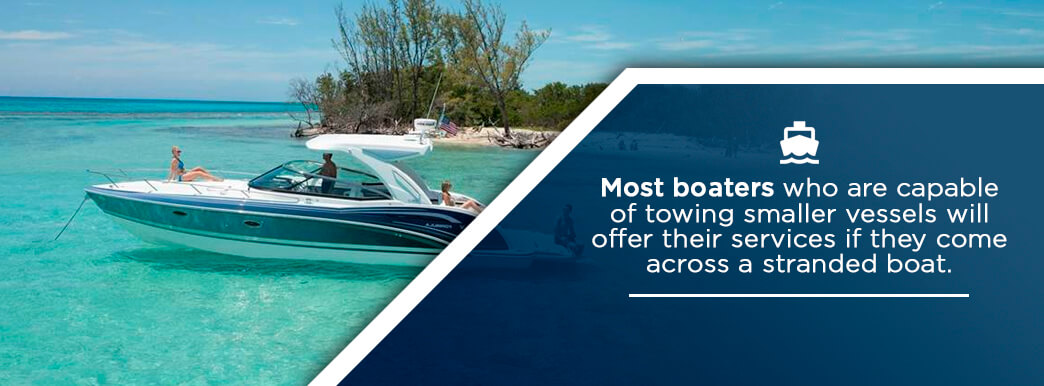
Most boaters who are capable of towing smaller vessels will offer their services if they come across a stranded boat. However, if your boat breaks down, you can’t be sure when or if a larger vessel will pass by, especially if you’re far off the coast or in a less populated area. In these situations, it’s best to have a plan of action, whether that means calling the coast guard or a tow company.
If you want to ensure you have a reliable towing option, should your boat become disabled, you can purchase membership plans with professional towing companies. There are different plans that offer basic boat tow assistance, unlimited towing in either freshwater or saltwater or higher-end membership. Depending on which you choose, there are different levels of coverage and reimbursements if you need a tow outside the company’s service areas.
Each plan provides yearly coverage for a single payment, ensuring you can get help when you need it. If you’re a frequent boater, these plans are an excellent way to make sure you have a trustworthy and capable tow at any time. The same companies also often provide on-water assistance and repairs, which can help if you want to get your vessel up and running again. The highest membership levels provide all the extra assistance and make sure you don’t have to pay out of pocket for towing.
About Formula Boats
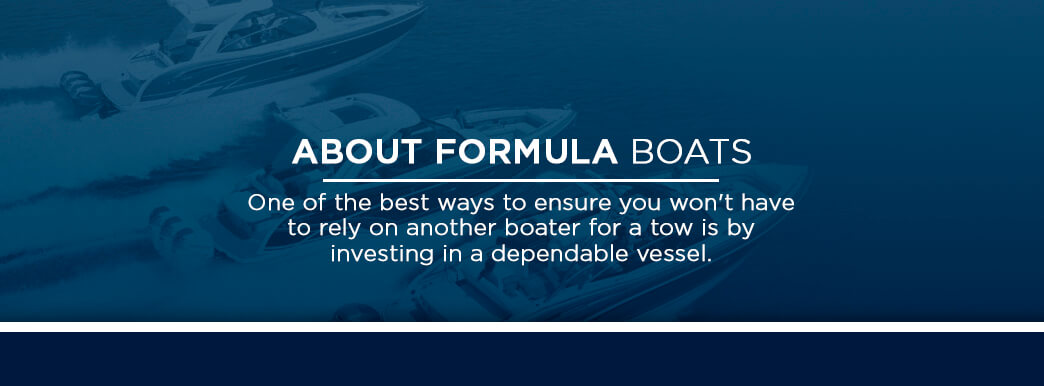
One of the best ways to ensure you won’t have to rely on another boater for a tow is by investing in a dependable vessel. Formula Boats produces top of the line powerboat models, known around the world for their style, engineering and proven performance. As a family-owned company, the philosophy of quality in all areas has been passed down through the years and three generations of employees.
Victor Porter, Formula Boats’ Chairman Emeritus, has spent over 60 years in the boating industry, and he brings his experience to the production and manufacturing of all the company’s speedboats. At Formula Boats, we have a distinctive focus on excellence in all areas, from craftsmanship to design to how they run in the water. Each boat is built with meticulous processes, ensuring you get a high-quality vessel that will bring you years of joy on the water.
With better care in the creation processes, you’ll have less to worry about in terms of repairs or breakdowns. Formula Boats produces boats with attention to detail and slows down the process to ensure each level is properly cured and applied. Beyond the manufacturing, we also offer excellent service plans with every vessel.
With our Formula Guard program, you’ll have the benefit of extended five-year warranties, access to our authorized service network and a direct line to our technical assistance group. With all these offerings, you’ll be covered in the event of any breakdown, from the towing services and on-water assistance to repairs and tech help.
Contact Formula Boats to Learn More
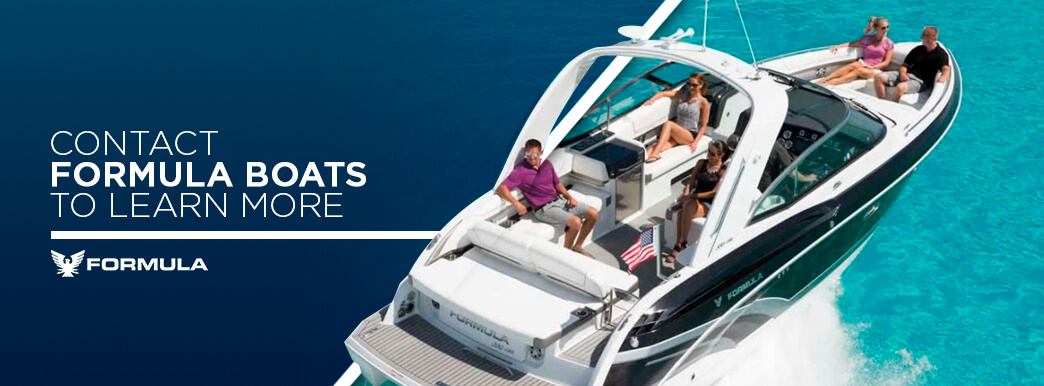
Formula Boats offers several different models of powerboat, from daytime cruisers to overnight yachts. The classes include bowriders, crossover bowriders, super sport crossovers, all sport crossovers, sun sports, performance cruisers and yachts. With the FormulaFlex programs, you can customize multiple elements of the vessel before manufacturing to give it a personalized feel. You’ll have your choice of upholstery, graphic colors, cabin fabrics and surfaces, electronics placements and more.
Learn more about all that Formula Boats has to offer — contact us today or request one of our free catalogs.
